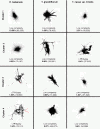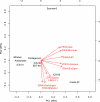Transposon fingerprinting using low coverage whole genome shotgun sequencing in cacao (Theobroma cacao L.) and related species
- PMID: 23883295
- PMCID: PMC3726317
- DOI: 10.1186/1471-2164-14-502
Transposon fingerprinting using low coverage whole genome shotgun sequencing in cacao (Theobroma cacao L.) and related species
Abstract
Background: Transposable elements (TEs) and other repetitive elements are a large and dynamically evolving part of eukaryotic genomes, especially in plants where they can account for a significant proportion of genome size. Their dynamic nature gives them the potential for use in identifying and characterizing crop germplasm. However, their repetitive nature makes them challenging to study using conventional methods of molecular biology. Next generation sequencing and new computational tools have greatly facilitated the investigation of TE variation within species and among closely related species.
Results: (i) We generated low-coverage Illumina whole genome shotgun sequencing reads for multiple individuals of cacao (Theobroma cacao) and related species. These reads were analysed using both an alignment/mapping approach and a de novo (graph based clustering) approach. (ii) A standard set of ultra-conserved orthologous sequences (UCOS) standardized TE data between samples and provided phylogenetic information on the relatedness of samples. (iii) The mapping approach proved highly effective within the reference species but underestimated TE abundance in interspecific comparisons relative to the de novo methods. (iv) Individual T. cacao accessions have unique patterns of TE abundance indicating that the TE composition of the genome is evolving actively within this species. (v) LTR/Gypsy elements are the most abundant, comprising c.10% of the genome. (vi) Within T. cacao the retroelement families show an order of magnitude greater sequence variability than the DNA transposon families. (vii) Theobroma grandiflorum has a similar TE composition to T. cacao, but the related genus Herrania is rather different, with LTRs making up a lower proportion of the genome, perhaps because of a massive presence (c. 20%) of distinctive low complexity satellite-like repeats in this genome.
Conclusions: (i) Short read alignment/mapping to reference TE contigs provides a simple and effective method of investigating intraspecific differences in TE composition. It is not appropriate for comparing repetitive elements across the species boundaries, for which de novo methods are more appropriate. (ii) Individual T. cacao accessions have unique spectra of TE composition indicating active evolution of TE abundance within this species. TE patterns could potentially be used as a "fingerprint" to identify and characterize cacao accessions.
Figures






Similar articles
-
Recent and dynamic transposable elements contribute to genomic divergence under asexuality.BMC Genomics. 2016 Nov 7;17(1):884. doi: 10.1186/s12864-016-3234-9. BMC Genomics. 2016. PMID: 27821059 Free PMC article.
-
Chromosomal distribution and evolution of abundant retrotransposons in plants: gypsy elements in diploid and polyploid Brachiaria forage grasses.Chromosome Res. 2015 Sep;23(3):571-82. doi: 10.1007/s10577-015-9492-6. Chromosome Res. 2015. PMID: 26386563
-
Illumina TruSeq synthetic long-reads empower de novo assembly and resolve complex, highly-repetitive transposable elements.PLoS One. 2014 Sep 4;9(9):e106689. doi: 10.1371/journal.pone.0106689. eCollection 2014. PLoS One. 2014. PMID: 25188499 Free PMC article.
-
Discovering and detecting transposable elements in genome sequences.Brief Bioinform. 2007 Nov;8(6):382-92. doi: 10.1093/bib/bbm048. Epub 2007 Oct 10. Brief Bioinform. 2007. PMID: 17932080 Review.
-
Identification and Genotyping of Transposable Element Insertions From Genome Sequencing Data.Curr Protoc Hum Genet. 2020 Sep;107(1):e102. doi: 10.1002/cphg.102. Curr Protoc Hum Genet. 2020. PMID: 32662945 Free PMC article. Review.
Cited by
-
Characterization of repeated DNA sequences in genomes of blue-flowered flax.BMC Evol Biol. 2019 Feb 26;19(Suppl 1):49. doi: 10.1186/s12862-019-1375-6. BMC Evol Biol. 2019. PMID: 30813893 Free PMC article.
-
Will Benchtop Sequencers Resolve the Sequencing Trade-off in Plant Genetics?Front Plant Sci. 2016 Apr 6;7:433. doi: 10.3389/fpls.2016.00433. eCollection 2016. Front Plant Sci. 2016. PMID: 27092154 Free PMC article. No abstract available.
-
Heterochromatin evolution in Arachis investigated through genome-wide analysis of repetitive DNA.Planta. 2019 May;249(5):1405-1415. doi: 10.1007/s00425-019-03096-4. Epub 2019 Jan 24. Planta. 2019. PMID: 30680457
-
Low-cost assembly of a cacao crop genome is able to resolve complex heterozygous bubbles.Hortic Res. 2019 Apr 6;6:44. doi: 10.1038/s41438-019-0125-7. eCollection 2019. Hortic Res. 2019. PMID: 30962937 Free PMC article.
-
Long Terminal Repeat Retrotransposon Content in Eight Diploid Sunflower Species Inferred from Next-Generation Sequence Data.G3 (Bethesda). 2016 Aug 9;6(8):2299-308. doi: 10.1534/g3.116.029082. G3 (Bethesda). 2016. PMID: 27233667 Free PMC article.
References
-
- Kelly LJ, Leitch IJ. Exploring giant plant genomes with next-generation sequencing technology. Chromosome Res. 2011;19:1–15. - PubMed
Publication types
MeSH terms
Substances
LinkOut - more resources
Full Text Sources
Other Literature Sources

